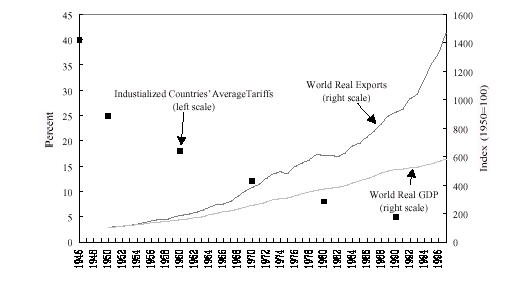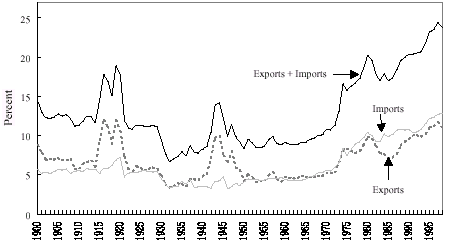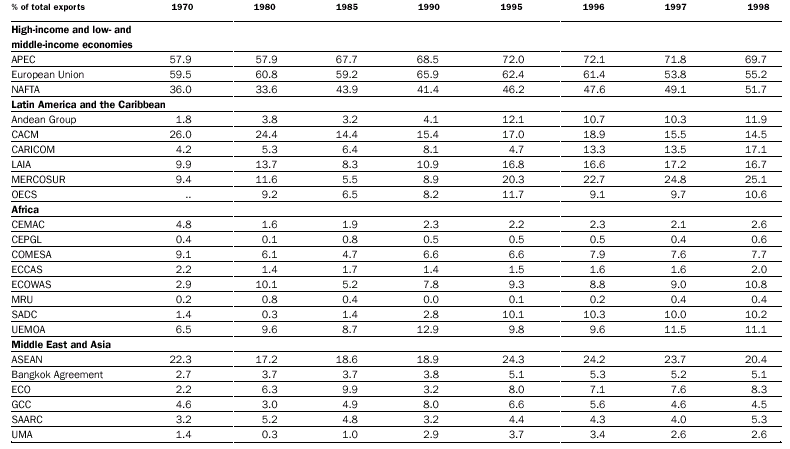|
|
|
|
|
|
|
The International Political Economy Since World War IIThe International Political Economy Since World War II (Full Text, PDF, 29 pages, 644 KB)
I. Introduction
A defining characteristic of the post-World War II era has been the dramatic increase in economic integration among the liberal capitalist countries, an increasing number of developing countries, and, during the past decade, a number of former communist nations that are undertaking a transition to more open markets. This note seeks to provide an introduction to this most dynamic part of the international system, and it seeks to do so by pursuing three specific objectives. The first is to provide a descriptive overview of the key features of the global economy since World War II. To achieve this objective, the first main section of the note reviews some of the most important trading patterns, cross-border financial transactions, and foreign direct investment activities that constitute the contemporary international economy, as well as the main mechanisms and modes of political interaction between countries that structure their economic relationships. The second main objective of the note is to provide an overview of the academic field of international political economy (IPE). The IPE field, as is detailed in the second main section of the note, seeks to understand the domestic and international political and economic sources of international economic cooperation and conflict, and, as a consequence, international economic openness and closure, as well as the domestic and international consequences of cross-national economic integration. The third main objective of the note, pursued in the note’s final main section, is to identify some of the key factors that may influence the future course of the world economy, factors that may serve either to enhance or to constrain international economic cooperation and integration in the future.
II. Overview of Main Characteristics of the International Economy Since World War II
1. Intensification of International Trade and Capital Flows
The remarkable increase in international economic integration since World War II can be observed with regard to trends in trade, finance, and foreign direct investment.
Trade
The integration of national economies through cross-border exchanges of goods and services has increased greatly since World War II. We may gain a sense of this increased integration from Exhibit 1, taken from a report by the U.S. Council on Economic Advisers, which provides indices for both total world exports and total world economic activity, as well as average tariff levels of the industrialized countries, during the period from 1950– to 1997.
As can be observed in the exhibit, the industrialized countries reduced their average tariffs after World War II from about 40% in 1946 to about 5% at the end of the 1990s. This helped to spur a boom in world exports; total real exports in 1997 were roughly 14 times that in 1950. By way of comparison, total real economic activity was only about six times greater in 1997 than in 1950.
Exhibit 1: Growth in World Real Exports and World Real Gross Domestic Product Since World War II

Source: U.S.,Council of Economic Advisors, America’s Interest in the World Trade Organization: An Economic Assessment, (Washington: Council of Economic Advisors, Novermber 16, 1999), p. 17
An important example of a country experiencing enhanced international trade integration is that of the United States. As can be observed in Exhibit 2, while U.S. exports and imports equaled less than 10% of U.S. Gross National Product (GNP) in the early 1950s, total U.S. trade equaled almost 25% of U.S. GNP at the end of the 1990s.
Exhibit 2:U.S. Trade and Gross National Product, 1900-1998

Source: U.S. Council of Economic Advisors, America’s Interest, p. 6
Within this general framework of international trade integration since World War II, there have been three particular developments. First, there has been an increase in what economists call "intra-industry trade"; rather than the exchange of shoes for computers, for instance, we often see exchanges across borders of similar goods. Second, many developing countries, especially in East and Southeast Asia, have integrated into the world economy with great success. This success on the part of the East Asian and Southeast Asian countries can be observed in Exhibit 3, which indicates that while these countries were the source of about 10% of total world exports in 1980, they were the source of about 16% of global exports in 1995.
Exhibit 3: Shares of Developing-Country Clusters in World Merchandise Exports 1985-1995

Source: World Trade Organization, Participation of Developing Countries in World Trade: Overview of Major Trends and Underlying Factors, (Geneva: WTO,1996), p. 8, and available on the World Wide Web at http://www.wto.org/english/tratop_e/devel_e/w15.htm.
The third main characteristic of the contemporary trading system is the continuing and perhaps growing importance of regional trading networks. This can be observed in Exhibit 4, which reports on trade encapsulation on the part of countries in various regional arrangements – that is, the percentage of total exports from countries in a particular trading arrangement that was shipped to countries in the same arrangement. As can be observed in the exhibit, while 40% of the exports from the United States, Canada, in Mexico (which formed a regional trading area under the terms of the North American Free Trade Agreement, or NAFTA, in 1993) went to one another’s markets in 1990, about 52% of exports went to regional partners in 1998. An even more pronounced regionalization of trade occurred between Argentina, Brazil, Uruguay, and Paraguay, which in 1991 formed the Common Market of the South, whose Spanish acronym is Mercosur. While about 9% of exports from these countries were shipped to regional partners in 1990, this increased to 25% by 1998. Only the countries that form the European Union (EU) appear to have experienced a decrease in regional concentration of trade during the 1990s (although in 1998 the figure still exceeded 50%), although this may have been due to the expansion in the membership of the EU during the period.
Exhibit 4:Regional Trade Encapsulation, 1970-1998

Source: World Bank, World Development Indicators 2000, available on the World Wide Web at http://www.worldbank.org/data/wdi2000/pdfs/tab6_5.pdf
Endnote
Note *: Joseph M. Grieco (Ph.D., Cornell, 1982) is Professor of Political Science at Duke University. He is the author of Cooperation Among Nations: Europe, America, and Non-Tariff Barriers to Trade (1990) and Between Dependency and Autonomy: India’s Experience with the International Computer Industry (1984). Articles and notes by him have appeared in Security Studies, Review of International Studies, the American Political Science Review, International Organization, the Journal of Politics, and World Politics. His teaching interests include theories of international relations, issues of international political economy, international business-government relations, the relationship between international economics and international security, and the rise of the European nation-state. During 1978-1979 he was a Pre-Doctoral Fellow at the Center for International Studies at Princeton University; during 1981-1982 he was a Post-Doctoral Fellow at the Harvard Business School; during 1985-1986 he was a German Marshall and a Paul Henri Spaak Post-Doctoral Fellow at the Center for International Affairs at Harvard University; during 1990-1991 he served with the Office of the United States Trade Representative and the International Monetary Fund as an International Affairs Fellow of the Council on Foreign Relations; and during 1998-2001 his research is being supported by a grant from the National Science Foundation. He has served as an intern with the U.S. Department of State and the Central Intelligence Agency. During the summer of 1994 he was the Karl W. Deutsch Visiting Professor at the Wissenschaftszentrum Berlin, and since May 1996 he has been a Visiting Professor at the Post-Graduate School of Economics and International Relations at the Catholic University of Milan. Back.